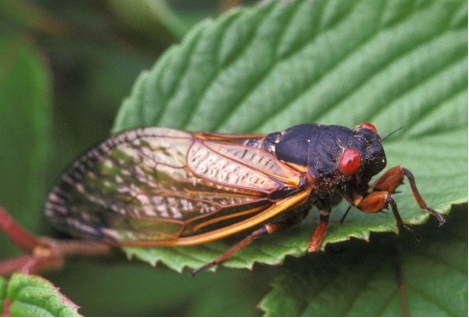Thought You Had Seen the Last of Them? Cicadas Return

Photo Courtesy of Wikimedia Commons.
Brood V Cicadas will be reappearing after 17 years underground.
May 27, 2016
Nature is filled with so many beautiful things: flowers, trees, birds and butterflies. But those aren’t the only things that rise from the soil…
This month after 17 years under the radar, Brood V Cicadas, disruptive, big, and noisy, are expected to hit certain parts of Maryland, as well as other areas across the U.S.
According to an April 15 Washington Post article, the cicadas will emerge in the billions in certain areas of Ohio, New York, Pennsylvania, Maryland, Virginia and West Virginia.
They come out of when the soil temperature rises to 64 degrees. However, it is still unclear whether cicadas will hit Montgomery County.
According to a cicada dedicated website called Cicada Mania, Garrett County is a definite target for the cicada invasion, but this year, the D.C./ Metro area may get lucky and avoid their path.
Marking their mating season, these insects come out of the ground on a 17-year cycle, swarming by the billions.
According to the Washington Post article, cicadas will get bigger over time and issue “deafening” cries as the males attempt to find female cicadas to mate with.
Cicadas are characterized by their hard shell, huge wings, and big red eyes that pop out of their heads, and no matter how many times people see these bugs, they don’t seem to get any more comfortable with them. Even adults, who have seen them before, are disturbed by their appearance.
“I am not a fan of cicadas,” CHS parent Dara Freeman said, “Their big red eyes creep me out.”
Each cicadas can lay up to 400 eggs, according to the Washington Post, and then die, leaving behind exoskeletons in the streets. Hear that crunch beneath your feet?
“I couldn’t even walk on my driveway to get to the main road for fear of them crawling on my feet,” Freeman said. “Our driveway was covered.”
As gross and bothersome as they are, cicadas also provide many benefits to the environment. They are a link in the food chain, providing a feast for other animals in the ecosystem every 17 years.
“A lot of people don’t realize that there are both annual and cyclical cicadas,” AP Environmental Science teacher Gary Rogers said. “They are a part of the food web every year, though some years more abundant than others.”
While some people might be dreading the resurfacing of this breed of cicadas, others are having an opposite reaction.
“I’m not sure what it is about them, but ever since I was little, I’ve been interested by them,” sophomore Riley Albert said.
Cicadas are also considered a delicacy in some cultures, so if you’re looking for something new to eat, you can try the big bug with bulging red eyes.
According to Rogers, if someone were to eat a cicada, it would be “a great source of protein.”
They may be nutritious, but that doesn’t mean they taste good.
“One flew into my mouth once,” freshman Jimmy Jin said, “At first it was sweet, but then it became bitter.”
Whether they are a delectable treat for some, or a noisy intrusion for others, get ready CHS. The forecast for these giant insects is still up in the air –they could miss us or swarm us.
“I’m super-excited,” Albert said, “I think it will be fun.”

